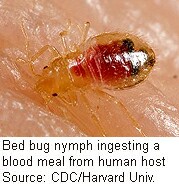
THURSDAY, April 19 (HealthDay News) — Add bedbugs to your list of potential occupational health hazards. A new report reveals nearly half of the employees of a U.S. government office in Tennessee were bitten by the blood-thirsty invaders while at work.
A bedbug-detecting German shepherd confirmed the infestation at an unidentified building in Clarksville, Tenn., last September, and investigators concluded that at least 35 workers had suffered bites. Although one woman had bite marks all over her body, the bugs didn’t cause serious health problems, according to the U.S. Centers for Disease Control and Prevention report.
Bedbugs can easily expand their territory beyond bedrooms, said Michael Potter, professor of entomology at the University of Kentucky in Lexington. “They start in homes and beds, and as people move about, they get transported into office buildings, schools, libraries, movie theaters, retail stores, you name it.”
Clarksville, home to about 125,000 people in north Tennessee, is one of many cities combating bedbugs in nonresidential settings in recent years. Bedbug infestations have soared since 2000 across the United States, sending even customers of luxury hotels and upmarket clothing stores into a panic.
A 2011 survey of U.S. pest control companies found that 38 percent had responded to infestations at office buildings, up from 17 percent the year before. Treatments at schools and day-care centers rose to 36 percent from 10 percent, and visits to hospitals jumped from 12 percent of their jobs to almost one-third.
Bedbugs bite people, often at night, and become engorged with their blood. The bites cause welts, itching and swelling. However, bedbugs do not carry disease like some other insects.
The building in question serves children and has 76 employees, said Dr. Jane Baumblatt, a CDC epidemic intelligence services officer based in Tennessee. Employees began reporting bites and itching last June, she said, and the state health department responded.
Theories about the source of the bites included scabies and fleas. But a German shepherd, one of many dogs around the country trained to detect bedbugs, found them in cubicles and offices within the building, Baumblatt said. Also, dermatologists confirmed that the bites were from bedbugs.
Baumblatt interviewed 61 employees and found that 35 had suffered from bites, often on their legs. “It wasn’t that severe. It was more of a nuisance than anything,” Baumblatt said.
“The anxiety was that people didn’t know what it was,” she said. “Once people figured out they were bedbugs, they were relieved.”
The office brought in a pest control company to rid the office of bedbugs and performed steam cleaning, Baumblatt said.
Potter, the entomologist, said bedbugs prefer beds and stationary furniture such as couches and recliners because they don’t like disruption when they feed on people. But they may be transported to offices, day-care centers or myriad other locations in personal belongings such as backpacks, briefcases and purses.
Once an office becomes infested, managers may not want to tell workers in order to avoid a panic, he said. “In the best of all worlds, the office would inform the employees that some bedbugs have been spotted and they have a pest control company that’s hopefully involved in dealing with things,” he said.
However, Potter added, “nothing is easy when it comes to bedbugs.”
The report was scheduled for presentation Tuesday at the CDC’s annual Epidemic Intelligence Services conference in Atlanta.
More information
The U.S. National Library of Medicine has details about bedbugs.

